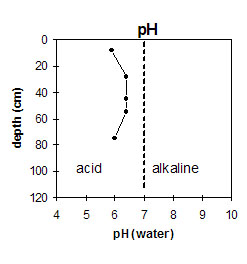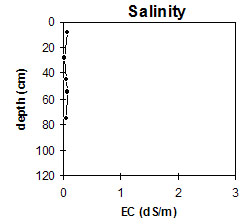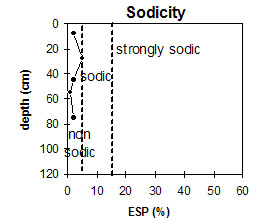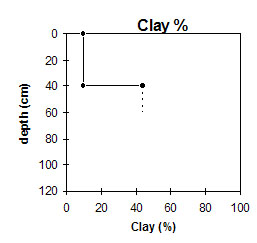NE8
| Location: Jarvis Creek | |
| General Landscape Description: Terrace or flat on a fan. |
Soil Profile Morphology:
Surface Soil
| A1 | 0-15 cm | Dark brown (10YR3/3); sandy clay loam; weak medium blocky structure; contains quartz gravel; pH 5.9: |
| A2 | 15-40 cm | Very pale brown (10YR7/3d) conspicuous bleach; sandy loam; very weak structure; pH 6.4: |
| Subsoil | ||
| B21 | 40-50 cm | Yellowish brown (10YR5/6); light medium clay; moderate medium blocky structure; sticky consistence wet; contains quartz gravel; pH 6.4: |
| B22 | 50-60 cm | Yellowish brown (10YR5/6); medium clay; moderate medium blocky structure; pH 6.4; wavy change to: |
| B23 | 60-90 cm | Dark red (2.5YR4/6) with strong brown (7.5YR4/6) mottles; sandy clay loam; contains quartz with weathered gneiss or shist and felspar as well as pockets of dark red (2.5YR4/6) containing gneiss material; tongues of the above horizon also make up 10-20 % of this layer; pH 6.0. |
Key Profile Features:
- Strong texture contrast between surface (A) horizon (10% clay) and sodic subsoil (B21) horizon (44% clay).
- Accumulation of quartz gravels throughout the profile.
Horizon | pH | Salinity Rating | ||
Surface (A1 horizon) | Moderately Acid | Very Low | Non-sodic | None (slight) |
Subsoil (B21 horizon) | Slightly Acid | Very Low | Non-sodic | None (strong) |
Deeper Subsoil (at 60-90 cm) | Moderately Acid | Very Low | Non-sodic | _ |
 |  |
The surface is moderately acid. The subsoil is slightly acid becoming moderately acid. | The salinity rating is very low throughout. |
|
|
The profile is non-sodic throughout. | There is a sharp increase in clay at 40 cm. |
Management Considerations:
Surface (A) Horizons
- The surface horizon is 40 % fine sand (72 % sand in total). When cultivated in a dry condition it will become ‘powdery’ and subsequent rainfall may result in surface sealing occurring. Soils such as these rely to a large extent on organic matter for maintaining aggregation. The levels of organic carbon measured at the pit site (which may or may not be representative of the whole paddock) is moderate. Organic matter levels will build up under pasture but will decline if cropping takes place. Practices such as residue retention, minimum tillage and including pasture rotations could be utilised if cropping takes place in order to build up organic matter, improve aggregation as well as assist in the low?? water holding capacity, low inherent fertility and reduce erosion risk. Planting legumes would also help to increase the low inherent fertility.
- The levels of total nitrogen measured at this pit site is moderate. However, this is best assessed by taking a bulked sample from across the paddock.
- The high sand content within the surface horizons will mean that the infiltration will be quite fast, slowing down at the clayey subsoil horizons. In fact, the subsurface (A2) horizon is bleached indicating that the layer is frequently water logged. This layer is also leached of essential nutrients necessary for plant growth.
- The low wilting point value (i.e. 5.5) of the surface (A1) horizon indicates that plants will be able to utilize very light rains when the soil is dry. However, due to the low water storage capacity, plants will soon suffer moisture stress unless further rain falls occur.
- The surface soil is non-sodic with no dispersion. The presence of slight dispersion after remoulding indicates that structural degradation (e.g. surface sealing, increased cloddiness) may occur if the soil is cultivated or overstocked in a moist to wet condition. Also, raindrop action on bare surface soil may also promote dispersion and promote a hardsetting condition. Surface cover should be maintained to protect against raindrop damage. The use of gypsum may also assist in ameliorating the surface soil.
- This subsoil is non-sodic with no dispersion. The soil does disperse strongly after remoulding which would normally inhibit root development and water movement down the profile. Mottling within the subsoil also indicates waterlogging. However, roots have been able to penetrate and were observed down to 60 cm depth.
- The subsoil has a low to moderate inherent fertility.
- The number of options for planting are good as there are no waterlogging or aluminium problems. However, due to the slumping subsurface (A2) it is best to use perennials rather than an agro plough to break up the subsoil and deep rooted species rather than deep ripping.




